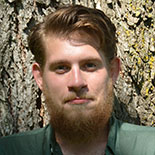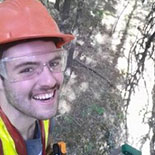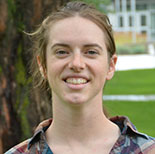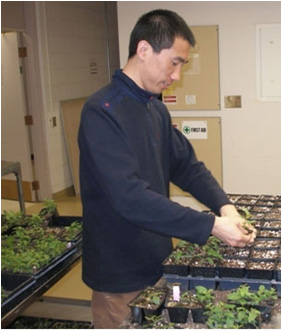

Postdoctoral Fellow
Jonathan A. Cale
Location: Earth Sciences Building
Email: jacale@ualberta.ca
Project:
- Understanding functional roles of volatile organic compounds emitted from bark beetle-associated fungi. As byproducts of heterotrophy and secondary metabolism, fungal volatile organic chemicals (FVOCs) are ubiquitous and diverse in nature as the fungi producing them. However, our understanding of the importance of these compounds to fungal interactions with insects, plants, and other fungi is a burgeoning aspect of fungal ecology. I investigate the ecological roles of FVOCs within a forest health context in order to elucidate the complexities of pest systems as well as develop innovative management approaches. Current systems being studied include the ecology of FVOCs from bark beetle-associated fungi as well as those from soil fungal communities.
- Effects of biotic and abiotic disturbances on soil microbial communities in western conifer forests. By promoting healthy, vigorous pine seedling development, soil fungal communities are critical factors of forest recovery to anthropogenic and natural disturbances, which are predicted to increase in frequency and/or intensity under climate change scenarios. I lead investigations seeks to understand the roles soil fungi play in boreal forest resistance and resilience in the face of changing disturbance patterns. We, myself, two graduate students and one undergraduate student, use observational and experimental approaches to understand (1) how soil fungal communities respond to various disturbance types (individual and successive), (2) whether such disturbance-impacted communities can be remediated to improve forest recovery, and how soil fungal communities drive pine seedling (3) development and carbon allocation as well as pine (4) defense physiology against insects and pathogens.

Jennifer Klutsch
Location: Earth Sciences Building
Email: klutsch@ualberta.ca
Project:
- The recent expansion of mountain pine beetle into jack pine has raised questions about the factors that impact the invasion of this bark beetle in a novel host. My studies investigate whether the native pathogen dwarf mistletoe and drought effect jack pine suitability by altering chemical defenses against mountain pine beetle. I also identify whether dwarf mistletoe infection changes the direction of interaction between mountain pine beetle and woodboring beetles. This research will contribute to our knowledge of systemic defense chemical coordination against multiple attacking organisms along with potentially identify stands susceptible to infestation that could be targeted for mitigation.

Harleen Kaur
Location: Earth Sciences Building
Email: harleen1@ualberta.ca
--- Go to top ---
Graduate Students
Jackson Beck
Co-adviser: Suzanne Simard
Location: Earth Sciences Building
Email: jlbeck@ualberta.ca
MSc: My project will determine if lodgepole pine is more susceptible to herbivores and pathogens when grown in cumulatively disturbed soils. I will conduct a greenhouse experiment to determine whether variation in soil fungal communities from cumulative disturbances differentially affects induction of defensive secondary chemicals. Specifically, metabolomic techniques will be used to compare the secondary chemistries of greenhouse-grown pine seedlings from five treatments simulating different attack-response scenarios. The question of whether or not variation in soil fungal communities changes the physiological susceptibility of pine to herbivores and pathogens has important consequences for the likelihood of disturbance (especially biotic) cascades in coming years.

Margarete Dettlaff
Co-adviser: JC Cahill
Location: Earth Sciences Building
Email: dettlaff@ualberta.ca
Ph.D: Margarete is broadly interested in how the interactions between plants and herbivores shape forest structure and function. For this project she is examining the chemical ecology of aspen trees in the parkland region of Alberta, specifically how their chemical defenses vary across the parkland region, how their chemical responses to various stressors interact, and what effect these chemical responses have on the dynamics of the aspen forest.

Evan Fellrath
Co-adviser: Justine Karst
Location: Earth Sciences Building
Email: fellrath@ualberta.ca
MSc: My research will assess the efficacy of triaging beetle-killed stands based on soil fungi. Previous research demonstrates that fungal communities in soils change following beetle-induced stand mortality with consequences for pine seedling survival and performance. I will investigate how communities of fungi in soils of beetle-killed stands vary across the landscape, and whether inoculation of pine seedlings with fungi from healthy pine stands can offset the effects of detrimental fungi occurring in soils of some beetle-killed stands.

Altaf Hussain
Location: Earth Sciences Building
Email: altaf2@ualberta.ca
Ph.D: My research concerns the spatial patterns in the dispersal mechanism of mountain pine beetle and investigating several aspects of the chemical defenses of jack pine in its diverse boreal habitats. In order to disperse, various phytochemicals are exploited by beetles as vital cues to locate and colonize suitable host trees. Trees on the other hand are sessile and can only fine-tune their defenses according to the threat and their limited resources e.g. soil moisture and nutrients. Trade-offs among defense compounds (e.g., terpenoids vs. phenolics) as well as among defense chemicals and non-structural carbohydrates are being investigated to underpin the ecological paradigm of beetle invasion potential in its naïve jack pine dominated habitats. The project supports the development of better forest protection methods.

Melanie Mullin
Location: Earth Sciences Building
Email: melanie.mullin@ualberta.ca
MSc: The lodgepole pine tree, Pinus contorta var. latifolia is Alberta’s provincial tree and critical to our forest industry. This conifer is also the host tree for mountain pine beetle, which are currently experiencing climate-changed induced range expansion. As of 2006, the mountain pine beetle outbreak reached Alberta. In light of this range expansion, and likelihood of continued climate change, it is timely to predict how lodgepole pine trees will fare along climate change gradients. High elevation and/or latitude are commonly used as proxies in climate change models. P. contorta’s primary defense mechanism against bark beetles lies in 1) the production of defense chemicals, and 2) the transformation of non-structural carbohydrates, to support continues production of defense chemicals. However, the impact of either elevation or latitude on either the defense chemicals or non-structural carbohydrate reserves of lodgepole pine is unknown. This begs the research question: are the chemical signatures of lodgepole pine trees occurring in higher elevation and latitudes different than those of conspecifics in lower systems? My research will likely suggest geographic areas where lodgepole pines are most vulnerable to attack. This is relevant in current and future forest management practices, especially where insect outbreaks and climate change are concerned.

Jean Carlos Rodriguez Ramos
Co-adviser: Justine Karst
Location: Earth Sciences Building
Email: jcrodrig@ualberta.ca
Ph.D: I will determine whether soil fungal communities vary among forests impacted by individual and cumulative disturbances. I conduct a field survey to determine if soil fungal communities differ among different disturbances such as fire, mountain pine beetle outbreak or harvesting scenarios. Specifically, I will examine differences in species composition, community structure, and community and functional diversity of fungi present within upper soil horizons. As part of this project, I will also determine if lodgepole pine seedling performance improves when grown in soils amended with undisturbed soils and primer plantings. Specifically, seedling biomass will be compared among different soil amendment volumes and presence/absence of primer plantings. These treatments will help identify the minimum soil and plant amendments needed to enhance pine growth.

Sydne Giselle Guevara Rozo
Location: Earth Sciences Building
Email: sydne@ualberta.ca
MSc: Recent studies showed that fungal associates of mountain pine beetle concentrated nitrogen in subcortical tissues surrounding beetle larvae. Furthermore, these fungi were found to be more efficient in concentrating N in trees with unlimited access to N when compared with trees without such resource, suggesting that these fungi can affect growth and development of immature beetles depending on tree growing conditions. I will assess whether the fitness of mountain pine beetle (i.e. fat body content and subsequent pheromone production) is affected when their immatures develop in N rich versus N poor hosts. The outlined studies will reveal how the fungal symbionts of MPB mediate the nutritional quality of tissues and how this affects beetle quality, particularly their ability to disperse.

Fuai Wang
Location: Earth Sciences Building
Email: fuai@ualberta.ca
MSc: Since the invasion of jack pine forests by the mountain pine beetle, how organisms native to the jack pine forests and mountain pine beetle will interact is not known. One of such native organism is Ips pini, pine engraver beetle. My research investigates the relationship between the mountain pine beetles associated fungi and I. pini associated fungi when the mountain pine beetles and pine engraver beetles attack and release the fungi at the same jack pine tree. I am particularly interested in if volatiles emitted by the same or different species of fungi have any effect on the host or competing bark beetle species.

Shiyang (Violet) Zhao
Location: Earth Sciences Building
Email: shiyang1@ualberta.ca
Ph.D: Since its first invasion of Alberta in 2006, mountain pine beetle left a gradient of stand level mortality. However, how surviving residual overstory pine trees in post-beetle stands will be affected by the sudden changes in stand conditions is hard to predict. Thus, understanding of the future of residual pine trees in post-beetle stands can have important implications for predicting future stand structure and long-term sustainability of pine trees in western Alberta. I am testing two distinct hypotheses. The Source Hypothesis tests whether residual trees are targeted by the secondary insects and diseases originating from beetle-killed trees, leading to sudden increases in their abundance. The Sink Hypothesis test whether beetle-killed trees are attacked by the opportunistic insects and diseases, however, pests cannot make the switch to the residual pine trees, and thus they die out.

--- Go to top ---
Undergraduate Students
Gail Classens
Email: gclassen@ualberta.ca
Christien Dykstra
NSERC-USRA undergraduate student
Email: cdykstra@ualberta.ca

Brosnon Peters
Email: brosnon@ualberta.ca
Marla Roth
Email: mnroth@ualberta.ca
--- Go to top ---
Lab Staff
Guncha Ishangullyeva
Title: Laboratory Supervisor
Location: Earth Sciences Building
Email: ishangul@ualberta.ca
--- Go to top ---
Former Graduate Students
Paul Cigan
Graduated: August 2013
Degree: MSc
L. Jessie Colgan
Graduated: August 2010
Degree: MSc

Devin Goodsman
Graduated: August 2012
Degree: PhD

Guncha Ishangullyeva
Graduated: August 2015
Degree: MSc
Sanat Kanekar
Graduated: January 2018
Degree: MSc

Jenny Lazebnik
Graduated: August 2012
Degree: MSc

Caitlin Mader
Graduated: January 2018
Degree: MSc

Ahmed Najar
Graduated: March 2017
Degree: PhD

Crisia Tabacaru
Graduated: August 2015
Degree: PhD

Spencer Taft
Graduated: August 2014
Degree: MSc
Janet Therrien
Graduated: August 2012
Degree: MSc

Ashley Wick
Graduated: August 2013
Degree: MSc
--- Go to top ---
Visitors
Paal Krokene
Position: Senior research scientist at Skogforsk & Professor at Norw. Univ. Life Sciences - UMB

--- Go to top ---
Former Lab Members
Caitlyn Andreas
NSERC-USRA undergraduate student (2011)
Alec Carrigy
NSERC-USRA undergraduate student (2014 - 2015)
Meghan Jacklin
NSERC-USRA undergraduate student (2012)
Inka Lusebrink
Postdoctoral Fellow (2008 - 2011)
Cary Ma
NSERC-USRA undergraduate student (2012)
Valerie Marshal
Undergraduate student (2014 - 2015)
Marlena Muskens
Undergraduate student (2013)
Dandan Peng
Visiting undergraduate student (2015)
Bin Shan
Postdoctoral Fellow (2011 - 2012)
Lin Yi
Visiting undergraduate student (2015)
Bin Zhang
Visiting PhD student
E-mail: zbin0235@gmail.com
Project: 1) The influence of Juvenile Hormone content on the
physiological, biological and morphological characteristics of
mountain pine beetle.
2) Understanding frequency and intensity of herbivory and
resource availability on aspen seedling growth and defenses. We
submitted one manuscript and are preparing another one.

--- Go to top ---
Home | Research | Publication | Teaching | Member | Positions | Chemical Analysis Services